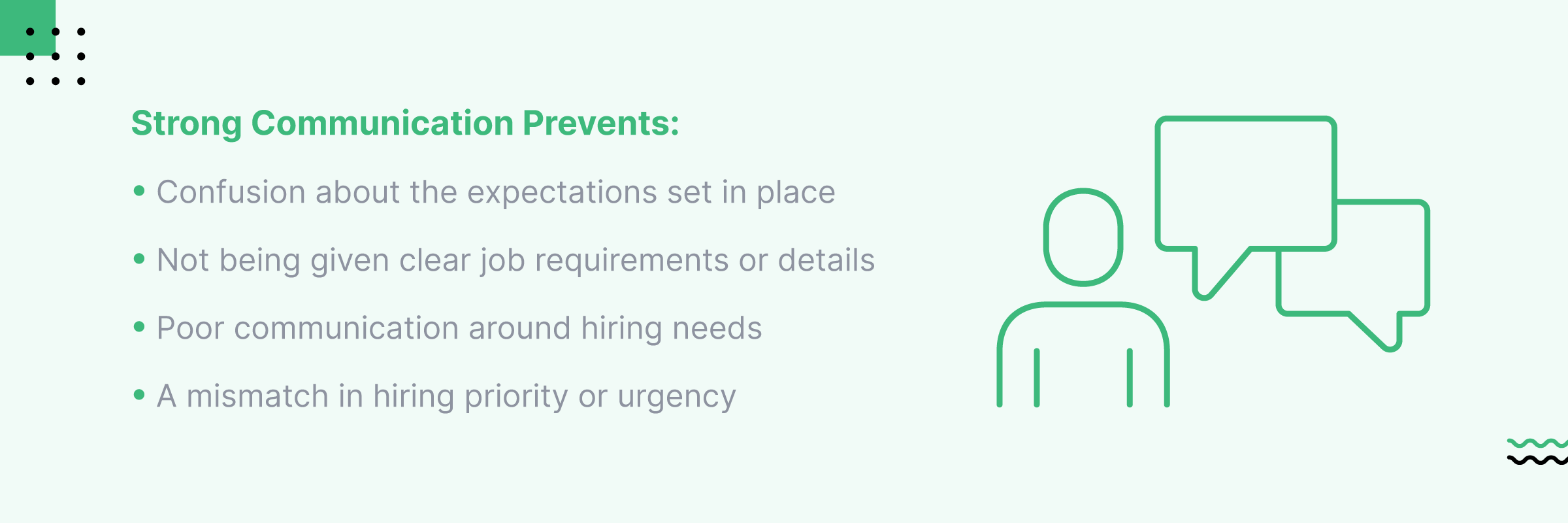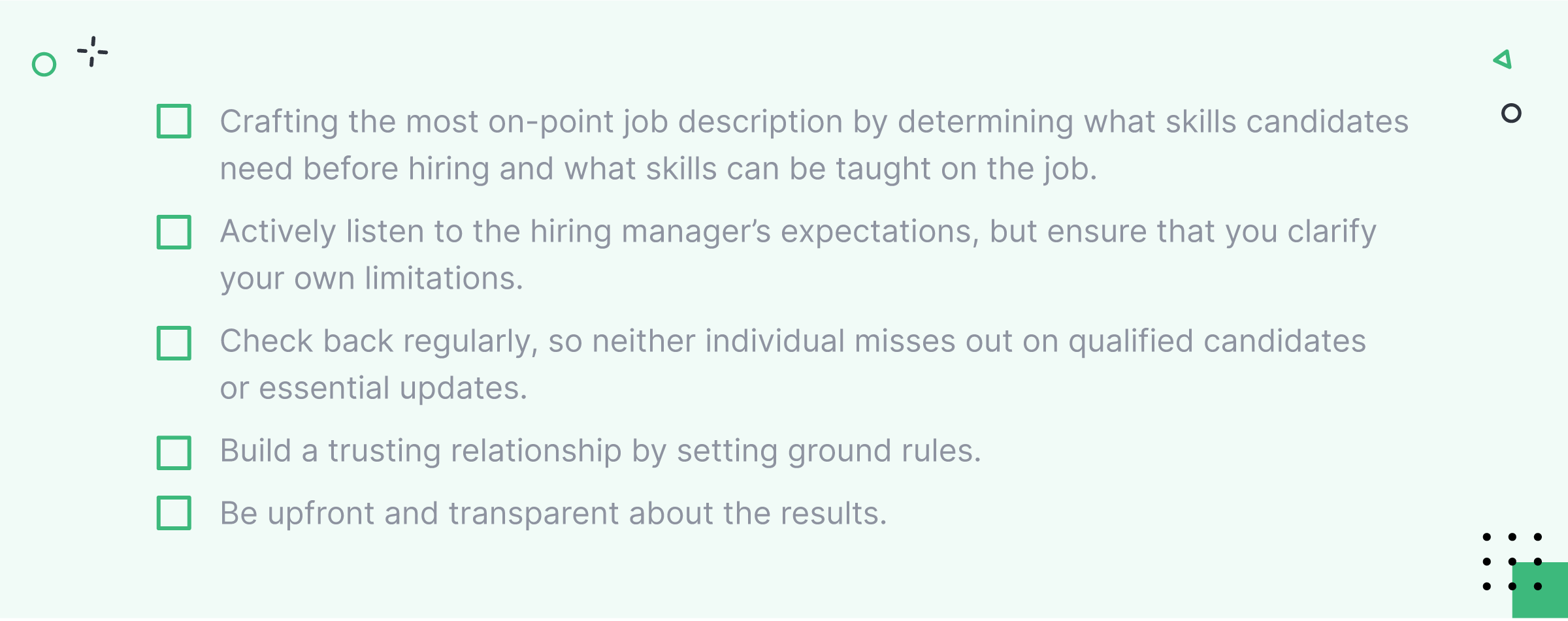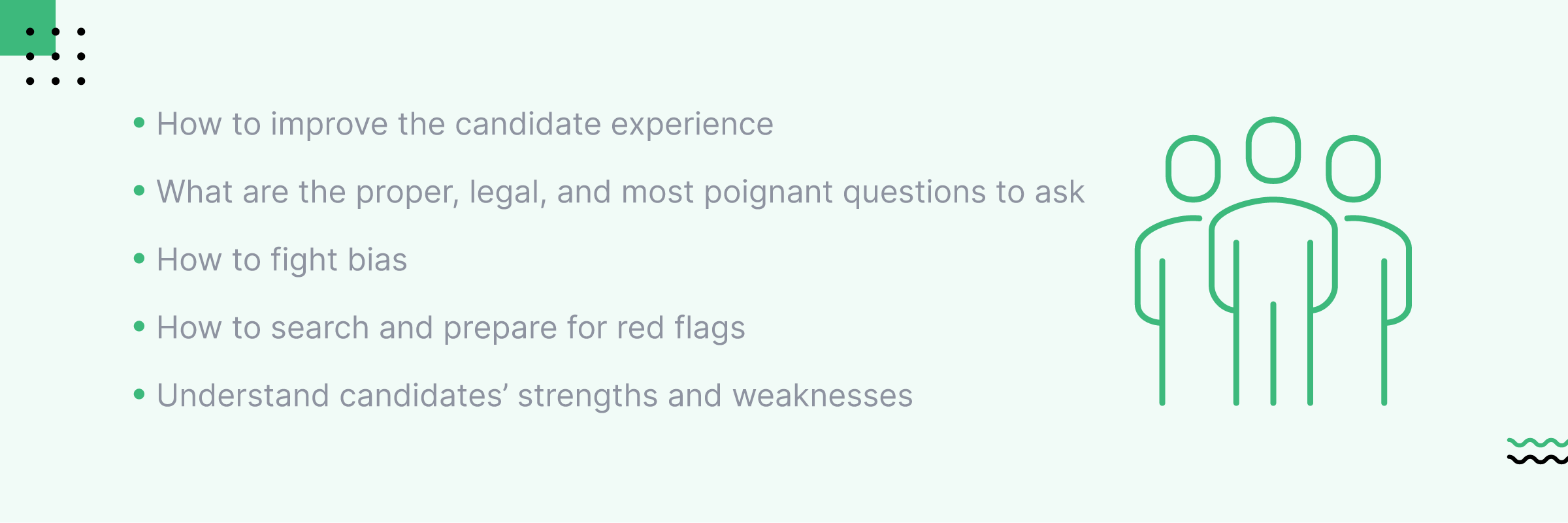Recruiters and hiring managers share a common goal: to hire the best candidates– fast. In an ideal world, communication between both parties would be smooth sailing. But due to the high-pressure stakes that each position holds, the relationship between hiring managers and recruiters often becomes tense. What’s more, is that the candidate often suffers as a result of this tension. So, let’s dive deep into the top 10 ways to improve the relationship between recruiters and hiring managers.
1. Set intentions right away.
Recruiters and hiring managers often have differing opinions on hiring strategy and time-to-hire, so getting on the same page is essential. Each party should be clear on what they are looking for and how to cooperate best to reach the same goal– hiring the most successful candidates. If everyone is transparent from day one, no one should have to experience the following:
- Confusion about the expectations set in place
- Not being given clear job requirements or details
- Poor communication around hiring needs
- A mismatch in hiring priority or urgency

Strong communication is key to unlocking a better relationship between recruiters and hiring managers. Both parties should set aside time to discuss goals, strategy, and expectations and answer top-of-mind questions. Schedule a kickoff call or in-person conversation to establish candidate qualifications, agree on a sourcing strategy, outline team responsibilities, and map out an interview plan.
2. Cooperate for the candidate.
Whether hiring managers are dissatisfied with the quality of candidates coming in or recruiters are being delivered unrealistic expectations from hiring managers, no one can seem to meet in the middle. But at the end of the day, these positions rely on each other. And an unhappy relationship between recruiters and hiring managers can negatively impact the candidate.
Without a positive relationship set between the hiring manager and recruiter, the candidate is at risk of a poor experience or may get completely lost in the wayside. Both of these outcomes can result in the candidate withdrawing their application, denying the offer, or avoiding purchasing a product or service in the future. So, be realistic, build trust, and remain consistent for your and the candidates’ sake.

3. Take advantage of your tech.
After the kickoff call, deadlines and service agreements should be set, and each individual should understand the tasks that need to be tackled going forward. Both parties must hold each other accountable to ensure the process runs smoothly. One of the best ways to do this is to embrace the flexible conditions of today’s advanced technology by considering the following:
Set reminders.
Setting reminders removes the burden of remembering everything or knowing what day to carry out what action. Plus, it helps with meeting compliance recruiting requirements.
Automate tasks.
Embrace the intuitive workflow of the modern age when you automate tasks. For example, you can restrict moving a candidate into the next step of the hiring process until either the hiring manager or recruiter has completed a task. This ensures everyone is on the same page and agrees with each process step.
It pays to automate: DYK that top candidates will drop out quickly because the top 10% of applicants will likely have another offer in just over a week?
4. Let communications flow.
Make it your goal to become a proactive communicator. No one is asking you to over-communicate here, but a brief email or quick note of a candidate’s offer status could go a long way. Try sending an email outlining a summary of proposed candidates or scheduling follow-up calls after interviews.
It’s important for recruiters and hiring managers to continuously identify and acknowledge each other’s needs while maintaining effective communication along the way. Because then both parties and the candidate will benefit from a more positive experience.
In an ideal world, communication between #Recruiting and #HiringManagers would be smooth sailing, but we know that’s not always the case. Here are 10 tips for a better recruiter-hiring manager bond: Share on X5. Prioritize staying realistic.
Because hiring managers can sometimes have very high expectations of recruiters, both parties should discuss the must-haves and nice-to-haves. Recruiters can source the perfect candidate, but hiring managers need to understand the realities of the time and effort it takes to set up a recruiting pipeline. So, setting realistic and reasonable expectations early is most beneficial. Some of the best practices to follow are:

The most successful recruiters are in close contact with their hiring managers because they receive frequent feedback and continuous updates on job requirements or candidate status changes.
6. Differing opinions on time-to-hire.
One of the most common grounds for miscommunication between recruiters and hiring managers is the time it takes to fill a position. When hiring managers want a shorter time to fill, the pressure is on. For a recruiter to keep the hiring manager continuously satisfied, it’s important to stay proactive, opt for transparency and metrics, and always alert them of last-minute surprises, such as different salary expectations. Continuously explain that an extended hiring process will usually result in poor-fit or toxic hires simply because the unemployed and desperate are more willing to wait out a long hiring process.
Additionally, an Applicant Tracking System can be a handy tool for adding transparency to the hiring process. An Applicant Tracking System (ATS) allows a single-pane view for the entire hiring team to access important data and metrics. These metrics can include the number of candidates interviewed, candidates’ status, and even reasons for rejection.
7. Clear job requirements are a necessity.
What if hiring managers don’t provide clear job requirements?
The best method to receive additional clarification is to ask more pointed questions. Upon interviewing the hiring manager, recruiters should avoid questions that are too generic, like, “What are you looking for in the candidate?” Instead, think of criteria that would make strong interview questions. For example:
What technology does the candidate need to be proficient in?
What skills would the ideal candidate have?
Who will the new hire report to, and what is the structure of their team?
To further refine the process, recruiters can perform internal research. By looking at the organizational chart, recruiters can identify the department’s role in the business, consider the team’s functionality, and assess the team’s long and short-term goals.
Case in point: When the cost of an extended hiring process is weighed against the cost of a poor hire, it becomes increasingly imperative to reduce long search times. The CFO’s office can be leveraged to help quantify this cost in dollar terms by analyzing data from roles that are already tracked in terms of dollars and cents, such as sales jobs.
This approach enables hiring managers to measure the decline in sales performance with each passing week during a recruitment effort, accurately illustrating the cost of poor hiring practices. Ultimately, this approach supports the case for shortening lengthy hiring processes to source higher-quality candidates and maximize profits.
External research can also save the recruiter and hiring manager precious time. By researching industry benchmarks, recruiters can discover the best candidate source and skill set for a specific position. This data is a great starting point, along with any additional requirements the hiring manager may have.
8. Overcoming mismatched incentives.
The many roles that recruiters and hiring managers have to fill can affect how they evaluate and compensate. Because a recruiter has to fill roles quickly, they may tend towards “short-term thinking.” This can lead to less fit candidates for the job or a less strategic hiring plan. This poses a risk that only increases when working with external or contract recruiters.
Mismatched incentives result in a rushed, messy process and a negative candidate experience. Hiring managers are not exempt from this scenario, but it is certainly something we could all work on. Learning to communicate, cooperate, and stay transparent will be the key to finding the most successful candidates. In the end, it is about working together.
9. The power of candidate feedback.
In a perfect world, hiring managers hire the first candidate they interview through a recruiter.
The truth is that hiring managers will decline candidates more than once. The goal is to understand why the candidate missed the mark and what can be done differently in the future.
It’s not enough for hiring managers to tell recruiters the candidate “just didn’t fit” or they weren’t “feeling them.” There is always a “why” to the equation, such as:
Why was the candidate not a good fit?
Are they lacking a certain type of skill?
Is their professional history not industry-specific enough?
No matter the information being dealt with, feedback is your best friend in these scenarios because it allows the recruiter to identify the ideal candidate better next time.
And at the end of the day, better communication saves everyone time and additional headaches. But by working together and asking the right questions, a recruiter-hiring manager relationship can stay strong and positive.
10. Let’s do this together.
Because some hiring managers may lack interview experience, recruiters shouldn’t hesitate to step in and walk them through the process. A recruiter’s knowledge and expertise are invaluable to newer hiring managers, especially when it comes to asking the right interview questions or preparing for red flags. It’s good to go over preferred communication styles first and always encourage the new hiring manager to express their views.
Things recruiters understand that they can share with new hiring managers:

BONUS TIP: Recruiter errors that frustrate hiring managers cost companies dearly – not just in wasted time but in lost opportunities and potential revenue. Errors like:
- Providing a candidate slate full of unqualified applicants
- Having top candidates drop out during the process
- Dealing with numerous no-shows for interviews
All of these can decrease recruiting efficiency, and cause a hiring manager to lose interest in following through with the process, and have detrimental impacts on organizational performance.
Recruiters must be vigilant about mistakes – constantly refining search techniques and implementing best practices to track qualified candidates and keep them engaged throughout the process. Ultimately, reducing recruiter errors results in cost savings and better hires that produce tangible value creation.
Recruiters should guide the hiring manager to focus on things that matter most, like relevant skills and a passion for the position. Additionally, the hiring manager can follow up after interviews to discuss their experience and express any questions or concerns.
Analyzing how you executed the process during prior hires will help identify where unnecessary and lengthy delays arise, like too many or too specific job specifications. Your role is to minimize these frustrations so that hiring managers maintain their focus and complete the recruitment process quickly. Recruiters can then advise them on their final decision.
Take a look at these 10 tips to improve your #recruiting and #hiring manager bonds: Share on XConclusively, hiring managers and recruiters can foster a stronger working relationship and succeed as a team with the proper time and willingness to communicate more openly and effectively. We all rely on each other, and recruiters and hiring managers have more in common than maybe they realize. After all, you can’t do your job alone and shouldn’t have to.

Director of Sourcing Operations at Visage, Evelyn has experience in agency, RPO, and in-house roles spanning 12 years in the recruitment industry. Evelyn has built and oversees a 4000-member global freelance sourcing community. Every Christmas in Ireland, she enjoys putting up her THREE Christmas trees.

